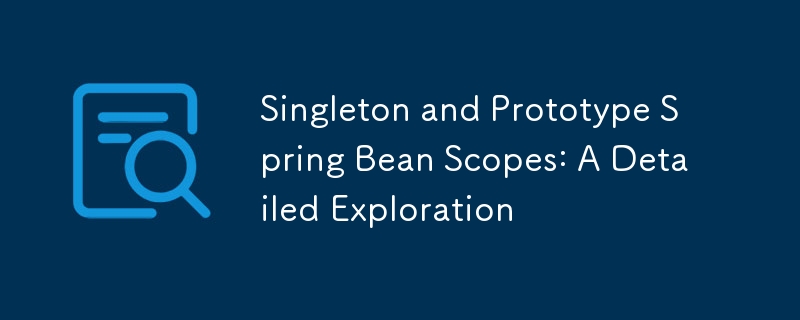Singleton 和原型 Spring Bean 範圍:詳細探索
- WBOY原創
- 2024-09-01 08:30:32994瀏覽

當我第一次開始使用 Spring 時,最讓我感興趣的概念之一是 bean 作用域的想法。 Spring 提供了各種 bean 作用域,用於確定在 Spring 容器內建立的 bean 的生命週期。最常用的兩個範圍是 Singleton 和 Prototype。了解這些範圍對於設計高效且有效的 Spring 應用程式至關重要,所以讓我帶您了解我對它們的了解。
了解 Spring Bean 範圍
在 Spring 中,bean 是由 Spring IoC(控制反轉)容器實例化、組裝和管理的物件。 Bean 作用域是指 bean 的生命週期-建立 bean 實例的方式和時間,以及它們的持續時間。
Spring 提供了幾種 bean 作用域,但我將重點關注的兩個是:
- 單例作用域
- 原型範圍
每個範圍都有其特定的用例,選擇正確的範圍可以顯著影響應用程式的行為和效能。
單例範圍
Singleton 作用域是 Spring 中預設的作用域,也是我最常使用的作用域。當使用 Singleton 範圍定義一個 bean 時,這表示 Spring 容器將只建立該 bean 的一個實例,並且該單一實例將在整個應用程式上下文中共用。
它是如何運作的
當我將一個 bean 宣告為 Singleton 時,Spring 在第一次要求時(在應用程式上下文啟動期間或首次引用它時)會建立該 bean 實例。之後,對該 bean 的每個後續請求都將傳回相同的實例。
這是一個簡單的例子:
@Configuration
public class AppConfig {
@Bean
public MyService myService() {
return new MyService();
}
}
在此範例中,myService() 是一個 Singleton bean。每次我從 Spring 上下文請求 MyService bean 時,我都會得到相同的實例。
Singleton Bean 的用例
我發現 Singleton 作用域非常適合無狀態 Bean——那些不保存任何客戶端特定資訊的 Bean。例如:
- 服務類別:通常,這些類別包含可以在應用程式之間共用的業務邏輯,而不需要單獨的實例。
- DAO 類別:由於它們通常與資料庫互動並且不維護特定於客戶端的狀態,因此單一實例就足夠了。
優點和注意事項
Singleton beans 的主要好處是記憶體效率。透過重複使用單一實例,應用程式消耗更少的內存,並且創建和銷毀物件的開銷最小化。然而,對維護狀態的 Singleton beans 保持謹慎是很重要的。如果 Singleton bean 無意中保存了狀態(例如實例變數),則該狀態可以在多個客戶端之間共享,從而導致潛在的資料不一致。
原型範圍
與 Singleton 相比,Prototype 範圍在每次從 Spring 容器要求 bean 時都會建立一個新的 bean 實例。當我了解到這一點時,很明顯 Prototype beans 對於每次使用都需要一個新實例的場景非常有用。
它是如何運作的
當使用 Prototype 作用域定義 bean 時,每次請求該 bean 時 Spring 都會傳回一個新實例。以下是我定義 Prototype bean 的方式:
@Configuration
public class AppConfig {
@Bean
@Scope("prototype")
public MyService myService() {
return new MyService();
}
}
在此範例中,每次我從 Spring 上下文要求 MyService bean 時,Spring 都會建立一個新的 MyService 實例。
原型 Bean 的用例
原型 Bean 在處理有狀態 Bean 時特別有用 - 那些維護某種特定於客戶端的狀態或每次使用都需要唯一配置的 Bean。一些典型的用例包括:
- Command Objects: If I’m implementing a pattern like Command, where each command is executed separately and maintains its own state, a Prototype bean is the right choice.
- Session or Request Scoped Beans: In web applications, beans that are specific to a user session or request can be defined as Prototype to ensure a new instance is created for each user or request.
Benefits and Considerations
The primary advantage of using Prototype beans is the flexibility it offers in creating new instances. This is particularly useful when dealing with stateful objects. However, there’s a trade-off in terms of performance and resource usage. Since a new instance is created every time, it can lead to higher memory consumption and more frequent garbage collection. Moreover, unlike Singleton beans, Spring does not manage the lifecycle of Prototype beans beyond creation, so I have to handle the destruction and cleanup of these beans manually.
Singleton vs. Prototype: Choosing the Right Scope
One of the key decisions I face when designing a Spring application is choosing between Singleton and Prototype scope. Here’s a summary of the factors I consider:
- Statefulness: If the bean is stateless, Singleton is usually the best choice. For stateful beans, Prototype is more appropriate.
- Resource Management: Singleton beans are more memory efficient since only one instance is maintained. Prototype beans, while offering more flexibility, consume more resources.
- Lifecycle Management: Singleton beans are managed by the Spring container throughout their lifecycle. In contrast, I must manage the full lifecycle of Prototype beans.
Practical Example
Let me provide a practical scenario that might help clarify when to use each scope. Suppose I’m building an online shopping application.
- Shopping Cart Service: This service would typically be stateless and would be a good candidate for a Singleton bean. There’s no need to create a new instance every time, and the same service can handle multiple requests.
- Order Processing: On the other hand, the Order object that represents a customer’s order would be stateful, holding details specific to that order. Therefore, it should be a Prototype bean so that each order is handled by a separate instance of the Order class.
Mixing Scopes: A Word of Caution
One thing I’ve learned the hard way is that mixing Singleton and Prototype beans can lead to unexpected issues. For example, injecting a Prototype-scoped bean into a Singleton bean can result in the Singleton bean always using the same instance of the Prototype bean. To avoid this, I usually inject a Provider or use the @Lookup annotation to ensure a new instance of the Prototype bean is created every time it is needed.
@Service
public class SingletonService {
@Autowired
private Provider<MyPrototypeService> myPrototypeServiceProvider;
public void usePrototypeService() {
MyPrototypeService prototypeService = myPrototypeServiceProvider.get();
prototypeService.execute();
}
}
In this example, myPrototypeServiceProvider.get() ensures that a new instance of MyPrototypeService is created every time it is called within the Singleton bean.
GoodBye !
Understanding the nuances of Singleton and Prototype bean scopes in Spring has been critical in my journey as a developer. Both scopes offer distinct advantages depending on the use case, and choosing the right one can significantly impact the performance and design of an application.
In my experience, Singleton is the go-to scope for most beans due to its efficiency and simplicity, while Prototype is reserved for those special cases where I need a fresh instance every time. By carefully considering the statefulness of my beans and how they are used within the application, I can make informed decisions that lead to better, more maintainable Spring applications.
以上是Singleton 和原型 Spring Bean 範圍:詳細探索的詳細內容。更多資訊請關注PHP中文網其他相關文章!

